Leadership and Change Report: Kotter's Model for Council Disputes
VerifiedAdded on 2020/02/14
|9
|2570
|56
Report
AI Summary
This report delves into the application of leadership principles and change management strategies, specifically focusing on a case study involving the Lemchester City Council and its park development project. The report highlights the challenges faced by the council, including internal disputes among employees and the need for efficiency improvements. It then explores Kotter's 8-step change model as a framework for resolving these issues and facilitating successful organizational change. The analysis covers each step of Kotter's model, from creating a sense of urgency and building a powerful coalition to communicating the vision, removing obstacles, generating short-term wins, consolidating gains, and anchoring the changes in the corporate culture. The report provides practical insights into how the council can implement these steps to foster a more productive and collaborative environment, ultimately achieving its goals for park development and community well-being. The report also references various academic sources to support its analysis.
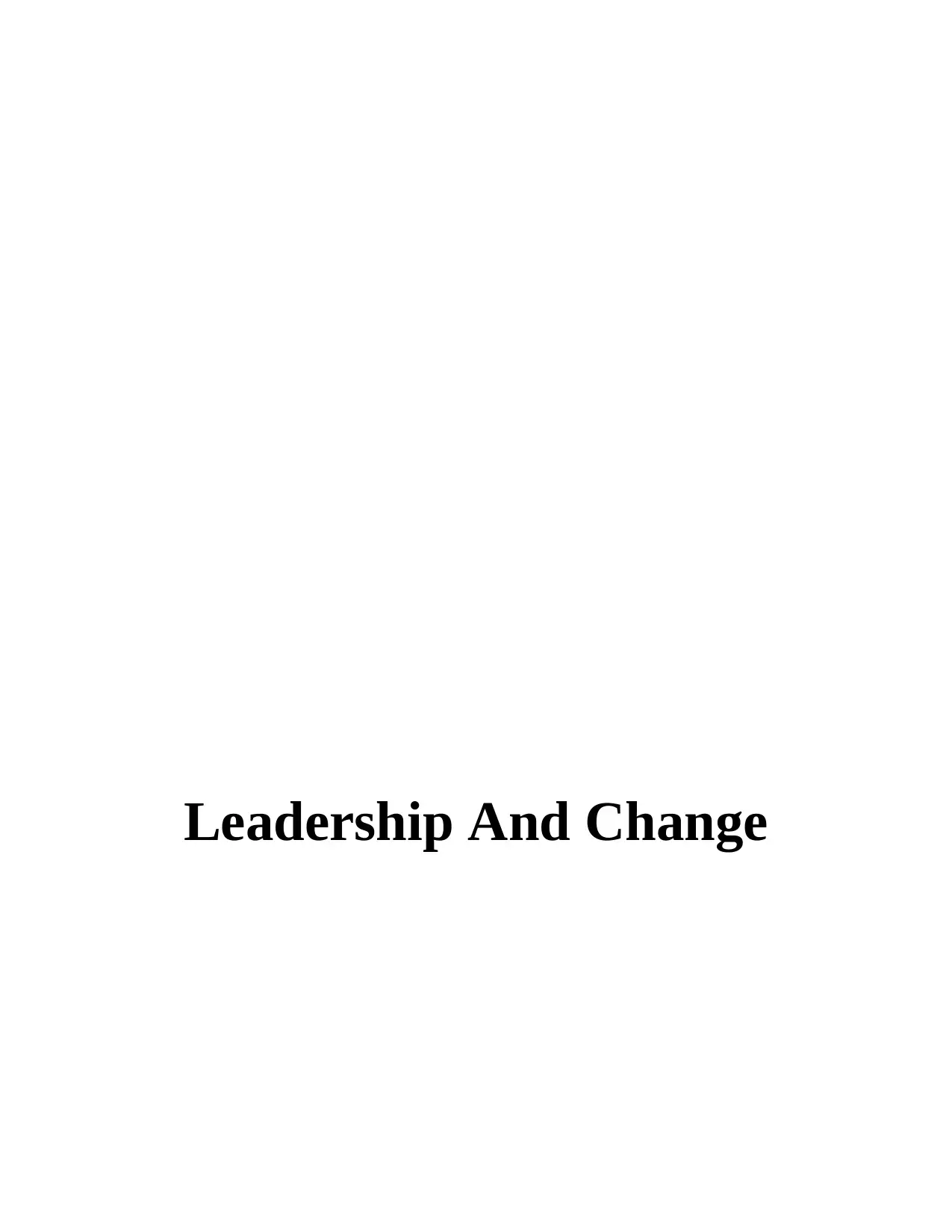
Leadership And Change
Paraphrase This Document
Need a fresh take? Get an instant paraphrase of this document with our AI Paraphraser
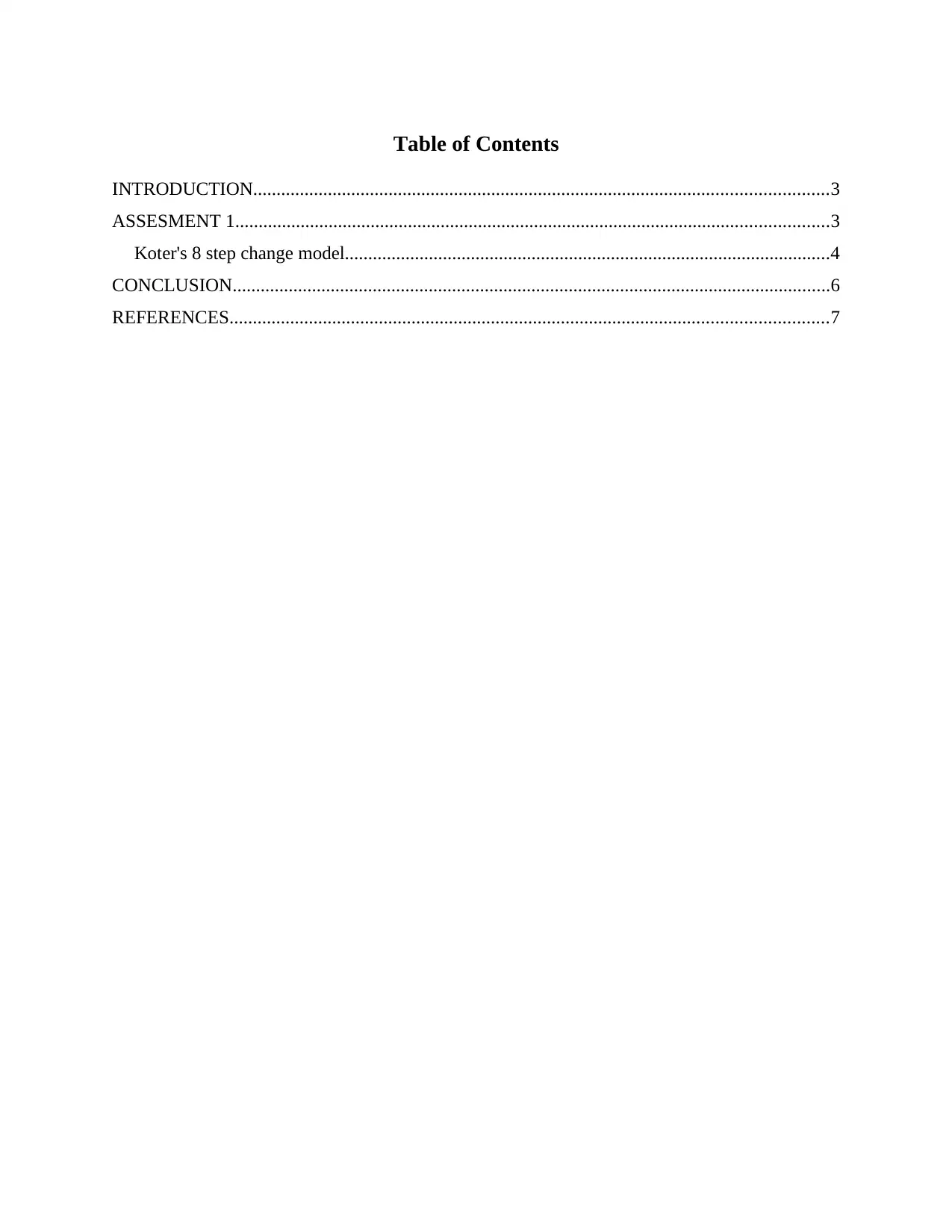
Table of Contents
INTRODUCTION...........................................................................................................................3
ASSESMENT 1...............................................................................................................................3
Koter's 8 step change model........................................................................................................4
CONCLUSION................................................................................................................................6
REFERENCES................................................................................................................................7
INTRODUCTION...........................................................................................................................3
ASSESMENT 1...............................................................................................................................3
Koter's 8 step change model........................................................................................................4
CONCLUSION................................................................................................................................6
REFERENCES................................................................................................................................7
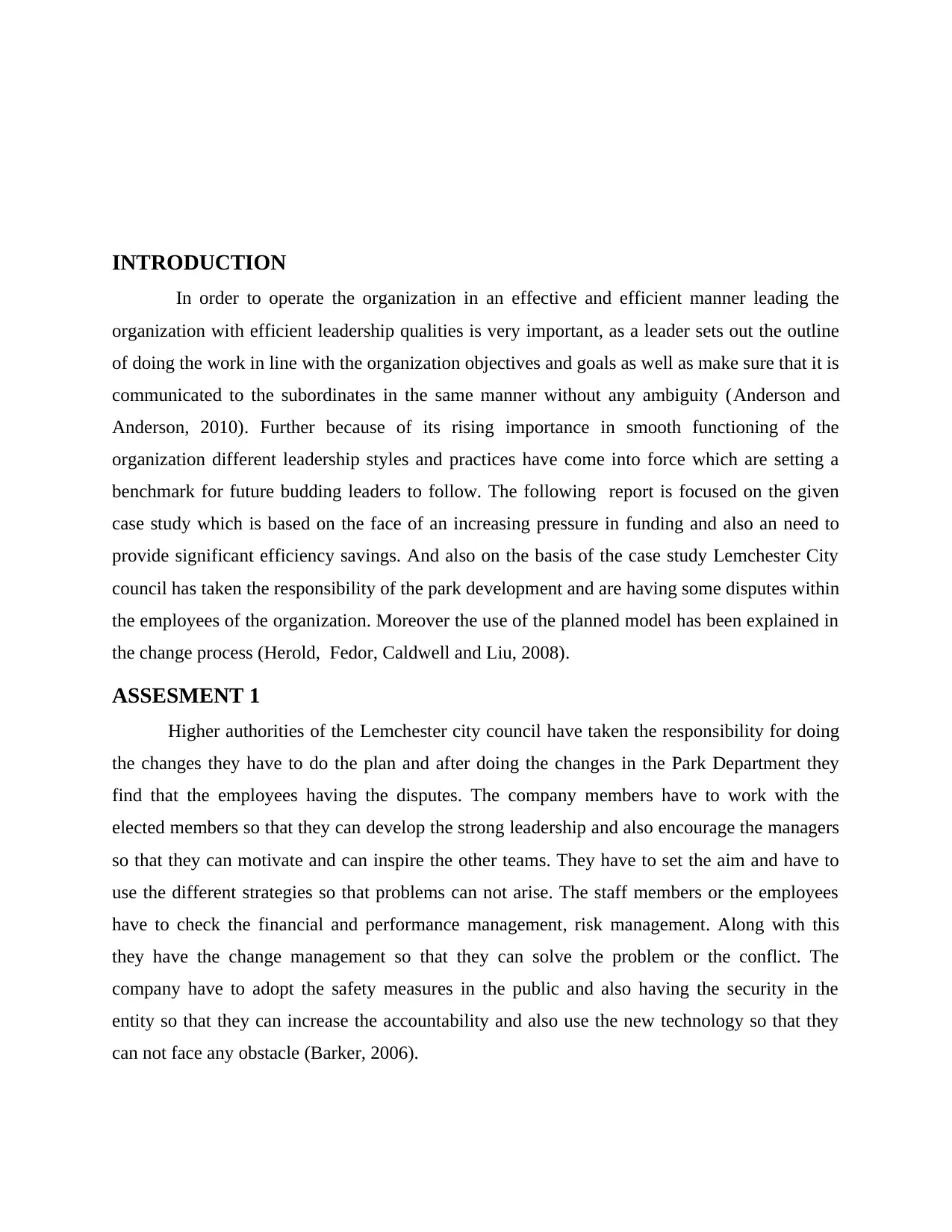
INTRODUCTION
In order to operate the organization in an effective and efficient manner leading the
organization with efficient leadership qualities is very important, as a leader sets out the outline
of doing the work in line with the organization objectives and goals as well as make sure that it is
communicated to the subordinates in the same manner without any ambiguity (Anderson and
Anderson, 2010). Further because of its rising importance in smooth functioning of the
organization different leadership styles and practices have come into force which are setting a
benchmark for future budding leaders to follow. The following report is focused on the given
case study which is based on the face of an increasing pressure in funding and also an need to
provide significant efficiency savings. And also on the basis of the case study Lemchester City
council has taken the responsibility of the park development and are having some disputes within
the employees of the organization. Moreover the use of the planned model has been explained in
the change process (Herold, Fedor, Caldwell and Liu, 2008).
ASSESMENT 1
Higher authorities of the Lemchester city council have taken the responsibility for doing
the changes they have to do the plan and after doing the changes in the Park Department they
find that the employees having the disputes. The company members have to work with the
elected members so that they can develop the strong leadership and also encourage the managers
so that they can motivate and can inspire the other teams. They have to set the aim and have to
use the different strategies so that problems can not arise. The staff members or the employees
have to check the financial and performance management, risk management. Along with this
they have the change management so that they can solve the problem or the conflict. The
company have to adopt the safety measures in the public and also having the security in the
entity so that they can increase the accountability and also use the new technology so that they
can not face any obstacle (Barker, 2006).
In order to operate the organization in an effective and efficient manner leading the
organization with efficient leadership qualities is very important, as a leader sets out the outline
of doing the work in line with the organization objectives and goals as well as make sure that it is
communicated to the subordinates in the same manner without any ambiguity (Anderson and
Anderson, 2010). Further because of its rising importance in smooth functioning of the
organization different leadership styles and practices have come into force which are setting a
benchmark for future budding leaders to follow. The following report is focused on the given
case study which is based on the face of an increasing pressure in funding and also an need to
provide significant efficiency savings. And also on the basis of the case study Lemchester City
council has taken the responsibility of the park development and are having some disputes within
the employees of the organization. Moreover the use of the planned model has been explained in
the change process (Herold, Fedor, Caldwell and Liu, 2008).
ASSESMENT 1
Higher authorities of the Lemchester city council have taken the responsibility for doing
the changes they have to do the plan and after doing the changes in the Park Department they
find that the employees having the disputes. The company members have to work with the
elected members so that they can develop the strong leadership and also encourage the managers
so that they can motivate and can inspire the other teams. They have to set the aim and have to
use the different strategies so that problems can not arise. The staff members or the employees
have to check the financial and performance management, risk management. Along with this
they have the change management so that they can solve the problem or the conflict. The
company have to adopt the safety measures in the public and also having the security in the
entity so that they can increase the accountability and also use the new technology so that they
can not face any obstacle (Barker, 2006).
⊘ This is a preview!⊘
Do you want full access?
Subscribe today to unlock all pages.

Trusted by 1+ million students worldwide
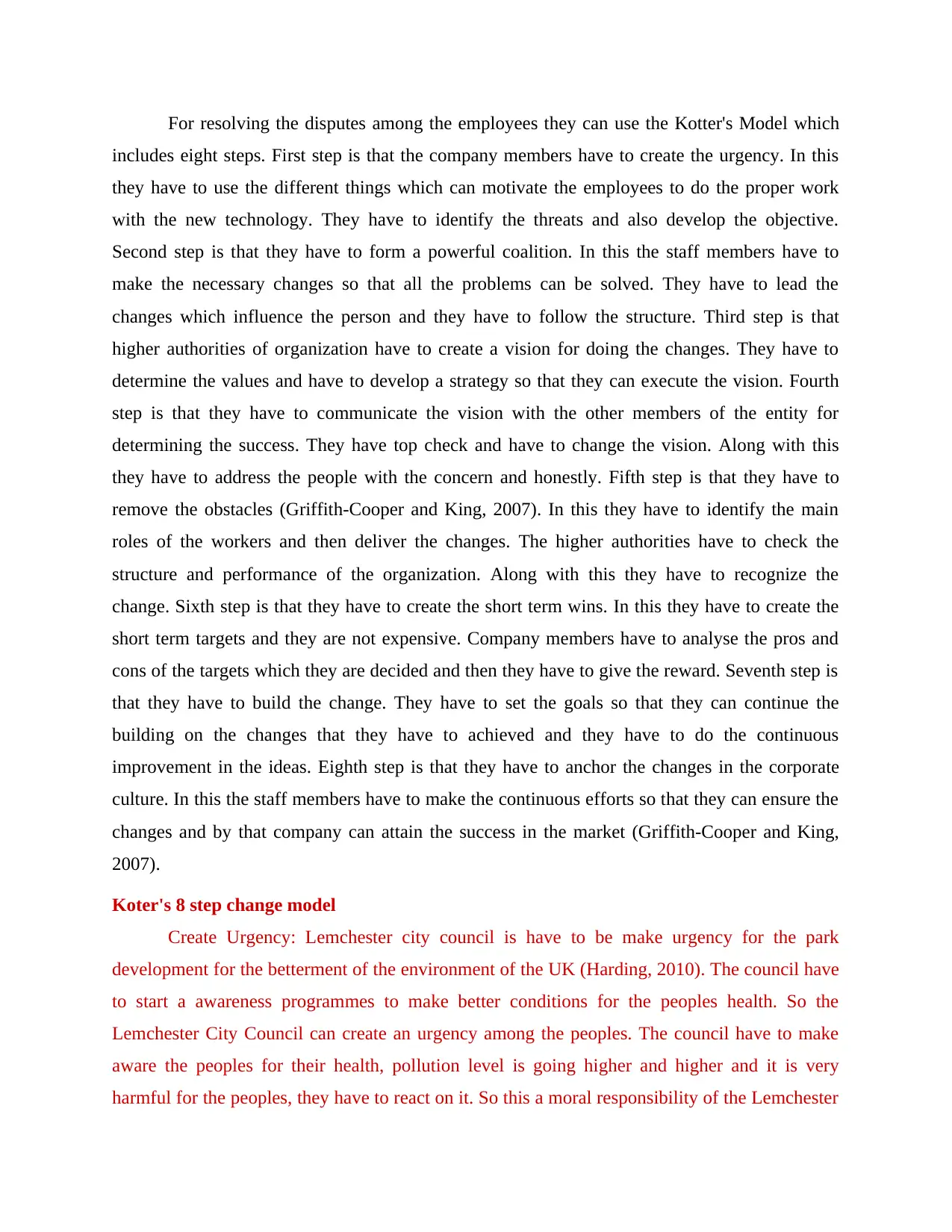
For resolving the disputes among the employees they can use the Kotter's Model which
includes eight steps. First step is that the company members have to create the urgency. In this
they have to use the different things which can motivate the employees to do the proper work
with the new technology. They have to identify the threats and also develop the objective.
Second step is that they have to form a powerful coalition. In this the staff members have to
make the necessary changes so that all the problems can be solved. They have to lead the
changes which influence the person and they have to follow the structure. Third step is that
higher authorities of organization have to create a vision for doing the changes. They have to
determine the values and have to develop a strategy so that they can execute the vision. Fourth
step is that they have to communicate the vision with the other members of the entity for
determining the success. They have top check and have to change the vision. Along with this
they have to address the people with the concern and honestly. Fifth step is that they have to
remove the obstacles (Griffith‐Cooper and King, 2007). In this they have to identify the main
roles of the workers and then deliver the changes. The higher authorities have to check the
structure and performance of the organization. Along with this they have to recognize the
change. Sixth step is that they have to create the short term wins. In this they have to create the
short term targets and they are not expensive. Company members have to analyse the pros and
cons of the targets which they are decided and then they have to give the reward. Seventh step is
that they have to build the change. They have to set the goals so that they can continue the
building on the changes that they have to achieved and they have to do the continuous
improvement in the ideas. Eighth step is that they have to anchor the changes in the corporate
culture. In this the staff members have to make the continuous efforts so that they can ensure the
changes and by that company can attain the success in the market (Griffith‐Cooper and King,
2007).
Koter's 8 step change model
Create Urgency: Lemchester city council is have to be make urgency for the park
development for the betterment of the environment of the UK (Harding, 2010). The council have
to start a awareness programmes to make better conditions for the peoples health. So the
Lemchester City Council can create an urgency among the peoples. The council have to make
aware the peoples for their health, pollution level is going higher and higher and it is very
harmful for the peoples, they have to react on it. So this a moral responsibility of the Lemchester
includes eight steps. First step is that the company members have to create the urgency. In this
they have to use the different things which can motivate the employees to do the proper work
with the new technology. They have to identify the threats and also develop the objective.
Second step is that they have to form a powerful coalition. In this the staff members have to
make the necessary changes so that all the problems can be solved. They have to lead the
changes which influence the person and they have to follow the structure. Third step is that
higher authorities of organization have to create a vision for doing the changes. They have to
determine the values and have to develop a strategy so that they can execute the vision. Fourth
step is that they have to communicate the vision with the other members of the entity for
determining the success. They have top check and have to change the vision. Along with this
they have to address the people with the concern and honestly. Fifth step is that they have to
remove the obstacles (Griffith‐Cooper and King, 2007). In this they have to identify the main
roles of the workers and then deliver the changes. The higher authorities have to check the
structure and performance of the organization. Along with this they have to recognize the
change. Sixth step is that they have to create the short term wins. In this they have to create the
short term targets and they are not expensive. Company members have to analyse the pros and
cons of the targets which they are decided and then they have to give the reward. Seventh step is
that they have to build the change. They have to set the goals so that they can continue the
building on the changes that they have to achieved and they have to do the continuous
improvement in the ideas. Eighth step is that they have to anchor the changes in the corporate
culture. In this the staff members have to make the continuous efforts so that they can ensure the
changes and by that company can attain the success in the market (Griffith‐Cooper and King,
2007).
Koter's 8 step change model
Create Urgency: Lemchester city council is have to be make urgency for the park
development for the betterment of the environment of the UK (Harding, 2010). The council have
to start a awareness programmes to make better conditions for the peoples health. So the
Lemchester City Council can create an urgency among the peoples. The council have to make
aware the peoples for their health, pollution level is going higher and higher and it is very
harmful for the peoples, they have to react on it. So this a moral responsibility of the Lemchester
Paraphrase This Document
Need a fresh take? Get an instant paraphrase of this document with our AI Paraphraser
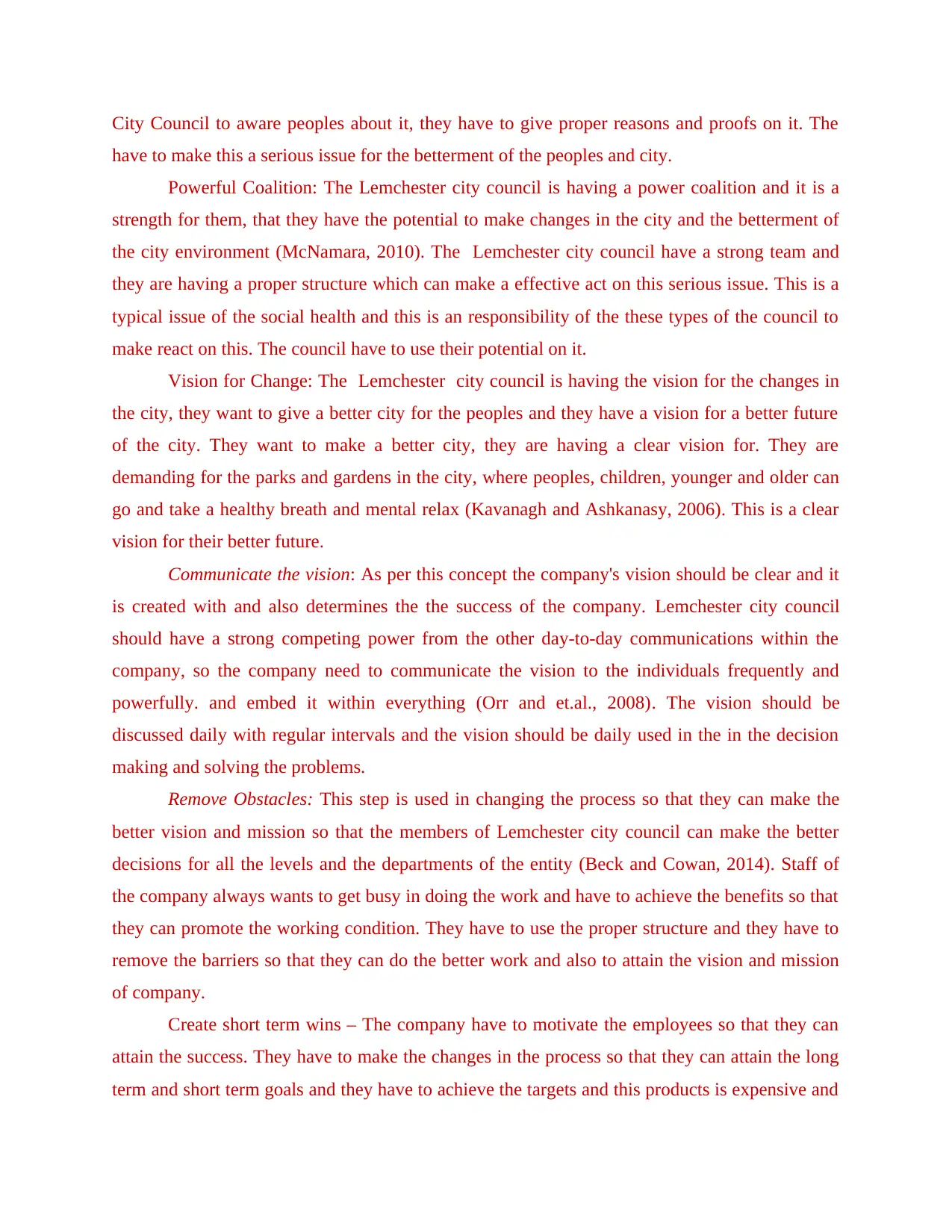
City Council to aware peoples about it, they have to give proper reasons and proofs on it. The
have to make this a serious issue for the betterment of the peoples and city.
Powerful Coalition: The Lemchester city council is having a power coalition and it is a
strength for them, that they have the potential to make changes in the city and the betterment of
the city environment (McNamara, 2010). The Lemchester city council have a strong team and
they are having a proper structure which can make a effective act on this serious issue. This is a
typical issue of the social health and this is an responsibility of the these types of the council to
make react on this. The council have to use their potential on it.
Vision for Change: The Lemchester city council is having the vision for the changes in
the city, they want to give a better city for the peoples and they have a vision for a better future
of the city. They want to make a better city, they are having a clear vision for. They are
demanding for the parks and gardens in the city, where peoples, children, younger and older can
go and take a healthy breath and mental relax (Kavanagh and Ashkanasy, 2006). This is a clear
vision for their better future.
Communicate the vision: As per this concept the company's vision should be clear and it
is created with and also determines the the success of the company. Lemchester city council
should have a strong competing power from the other day-to-day communications within the
company, so the company need to communicate the vision to the individuals frequently and
powerfully. and embed it within everything (Orr and et.al., 2008). The vision should be
discussed daily with regular intervals and the vision should be daily used in the in the decision
making and solving the problems.
Remove Obstacles: This step is used in changing the process so that they can make the
better vision and mission so that the members of Lemchester city council can make the better
decisions for all the levels and the departments of the entity (Beck and Cowan, 2014). Staff of
the company always wants to get busy in doing the work and have to achieve the benefits so that
they can promote the working condition. They have to use the proper structure and they have to
remove the barriers so that they can do the better work and also to attain the vision and mission
of company.
Create short term wins – The company have to motivate the employees so that they can
attain the success. They have to make the changes in the process so that they can attain the long
term and short term goals and they have to achieve the targets and this products is expensive and
have to make this a serious issue for the betterment of the peoples and city.
Powerful Coalition: The Lemchester city council is having a power coalition and it is a
strength for them, that they have the potential to make changes in the city and the betterment of
the city environment (McNamara, 2010). The Lemchester city council have a strong team and
they are having a proper structure which can make a effective act on this serious issue. This is a
typical issue of the social health and this is an responsibility of the these types of the council to
make react on this. The council have to use their potential on it.
Vision for Change: The Lemchester city council is having the vision for the changes in
the city, they want to give a better city for the peoples and they have a vision for a better future
of the city. They want to make a better city, they are having a clear vision for. They are
demanding for the parks and gardens in the city, where peoples, children, younger and older can
go and take a healthy breath and mental relax (Kavanagh and Ashkanasy, 2006). This is a clear
vision for their better future.
Communicate the vision: As per this concept the company's vision should be clear and it
is created with and also determines the the success of the company. Lemchester city council
should have a strong competing power from the other day-to-day communications within the
company, so the company need to communicate the vision to the individuals frequently and
powerfully. and embed it within everything (Orr and et.al., 2008). The vision should be
discussed daily with regular intervals and the vision should be daily used in the in the decision
making and solving the problems.
Remove Obstacles: This step is used in changing the process so that they can make the
better vision and mission so that the members of Lemchester city council can make the better
decisions for all the levels and the departments of the entity (Beck and Cowan, 2014). Staff of
the company always wants to get busy in doing the work and have to achieve the benefits so that
they can promote the working condition. They have to use the proper structure and they have to
remove the barriers so that they can do the better work and also to attain the vision and mission
of company.
Create short term wins – The company have to motivate the employees so that they can
attain the success. They have to make the changes in the process so that they can attain the long
term and short term goals and they have to achieve the targets and this products is expensive and
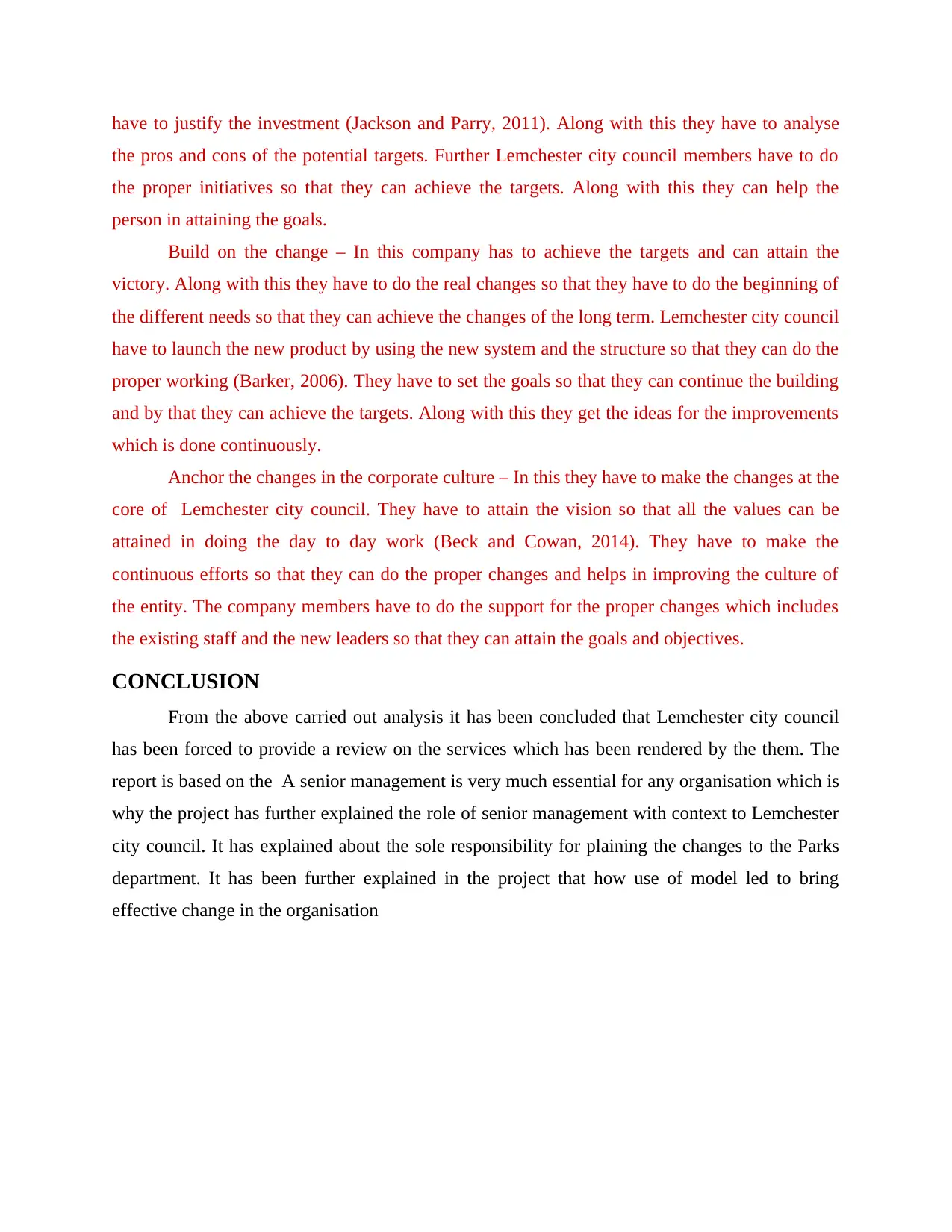
have to justify the investment (Jackson and Parry, 2011). Along with this they have to analyse
the pros and cons of the potential targets. Further Lemchester city council members have to do
the proper initiatives so that they can achieve the targets. Along with this they can help the
person in attaining the goals.
Build on the change – In this company has to achieve the targets and can attain the
victory. Along with this they have to do the real changes so that they have to do the beginning of
the different needs so that they can achieve the changes of the long term. Lemchester city council
have to launch the new product by using the new system and the structure so that they can do the
proper working (Barker, 2006). They have to set the goals so that they can continue the building
and by that they can achieve the targets. Along with this they get the ideas for the improvements
which is done continuously.
Anchor the changes in the corporate culture – In this they have to make the changes at the
core of Lemchester city council. They have to attain the vision so that all the values can be
attained in doing the day to day work (Beck and Cowan, 2014). They have to make the
continuous efforts so that they can do the proper changes and helps in improving the culture of
the entity. The company members have to do the support for the proper changes which includes
the existing staff and the new leaders so that they can attain the goals and objectives.
CONCLUSION
From the above carried out analysis it has been concluded that Lemchester city council
has been forced to provide a review on the services which has been rendered by the them. The
report is based on the A senior management is very much essential for any organisation which is
why the project has further explained the role of senior management with context to Lemchester
city council. It has explained about the sole responsibility for plaining the changes to the Parks
department. It has been further explained in the project that how use of model led to bring
effective change in the organisation
the pros and cons of the potential targets. Further Lemchester city council members have to do
the proper initiatives so that they can achieve the targets. Along with this they can help the
person in attaining the goals.
Build on the change – In this company has to achieve the targets and can attain the
victory. Along with this they have to do the real changes so that they have to do the beginning of
the different needs so that they can achieve the changes of the long term. Lemchester city council
have to launch the new product by using the new system and the structure so that they can do the
proper working (Barker, 2006). They have to set the goals so that they can continue the building
and by that they can achieve the targets. Along with this they get the ideas for the improvements
which is done continuously.
Anchor the changes in the corporate culture – In this they have to make the changes at the
core of Lemchester city council. They have to attain the vision so that all the values can be
attained in doing the day to day work (Beck and Cowan, 2014). They have to make the
continuous efforts so that they can do the proper changes and helps in improving the culture of
the entity. The company members have to do the support for the proper changes which includes
the existing staff and the new leaders so that they can attain the goals and objectives.
CONCLUSION
From the above carried out analysis it has been concluded that Lemchester city council
has been forced to provide a review on the services which has been rendered by the them. The
report is based on the A senior management is very much essential for any organisation which is
why the project has further explained the role of senior management with context to Lemchester
city council. It has explained about the sole responsibility for plaining the changes to the Parks
department. It has been further explained in the project that how use of model led to bring
effective change in the organisation
⊘ This is a preview!⊘
Do you want full access?
Subscribe today to unlock all pages.

Trusted by 1+ million students worldwide
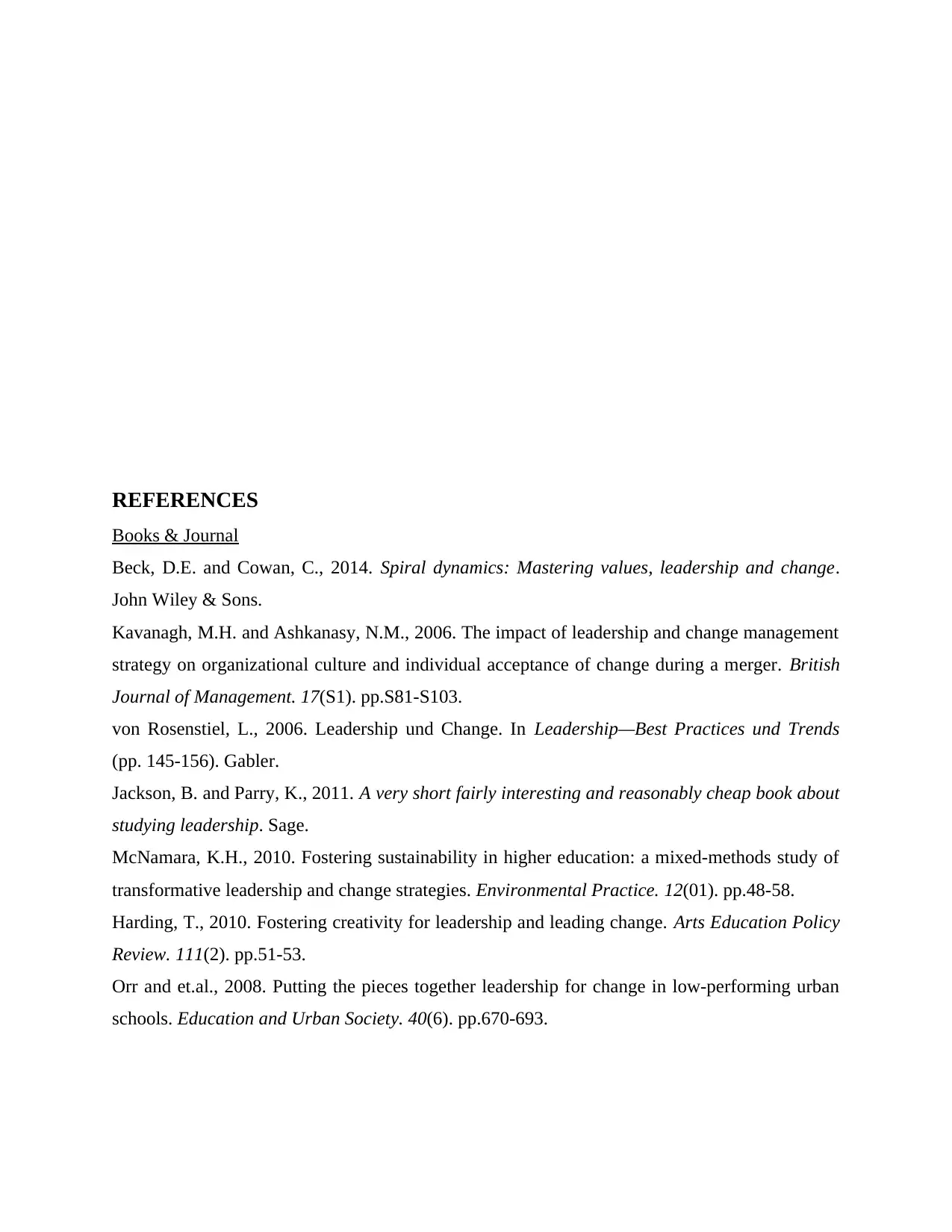
REFERENCES
Books & Journal
Beck, D.E. and Cowan, C., 2014. Spiral dynamics: Mastering values, leadership and change.
John Wiley & Sons.
Kavanagh, M.H. and Ashkanasy, N.M., 2006. The impact of leadership and change management
strategy on organizational culture and individual acceptance of change during a merger. British
Journal of Management. 17(S1). pp.S81-S103.
von Rosenstiel, L., 2006. Leadership und Change. In Leadership—Best Practices und Trends
(pp. 145-156). Gabler.
Jackson, B. and Parry, K., 2011. A very short fairly interesting and reasonably cheap book about
studying leadership. Sage.
McNamara, K.H., 2010. Fostering sustainability in higher education: a mixed-methods study of
transformative leadership and change strategies. Environmental Practice. 12(01). pp.48-58.
Harding, T., 2010. Fostering creativity for leadership and leading change. Arts Education Policy
Review. 111(2). pp.51-53.
Orr and et.al., 2008. Putting the pieces together leadership for change in low-performing urban
schools. Education and Urban Society. 40(6). pp.670-693.
Books & Journal
Beck, D.E. and Cowan, C., 2014. Spiral dynamics: Mastering values, leadership and change.
John Wiley & Sons.
Kavanagh, M.H. and Ashkanasy, N.M., 2006. The impact of leadership and change management
strategy on organizational culture and individual acceptance of change during a merger. British
Journal of Management. 17(S1). pp.S81-S103.
von Rosenstiel, L., 2006. Leadership und Change. In Leadership—Best Practices und Trends
(pp. 145-156). Gabler.
Jackson, B. and Parry, K., 2011. A very short fairly interesting and reasonably cheap book about
studying leadership. Sage.
McNamara, K.H., 2010. Fostering sustainability in higher education: a mixed-methods study of
transformative leadership and change strategies. Environmental Practice. 12(01). pp.48-58.
Harding, T., 2010. Fostering creativity for leadership and leading change. Arts Education Policy
Review. 111(2). pp.51-53.
Orr and et.al., 2008. Putting the pieces together leadership for change in low-performing urban
schools. Education and Urban Society. 40(6). pp.670-693.
Paraphrase This Document
Need a fresh take? Get an instant paraphrase of this document with our AI Paraphraser
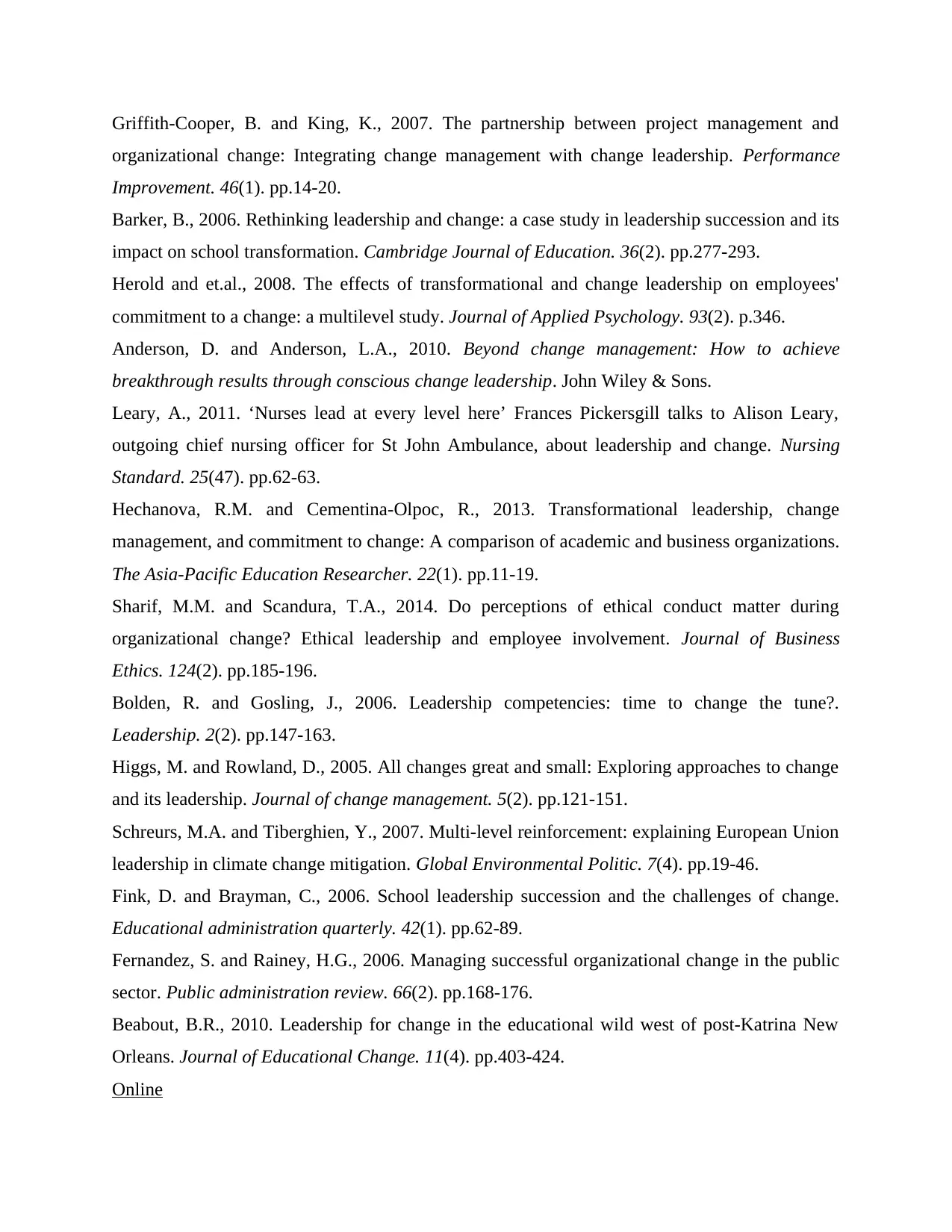
Griffith‐Cooper, B. and King, K., 2007. The partnership between project management and
organizational change: Integrating change management with change leadership. Performance
Improvement. 46(1). pp.14-20.
Barker, B., 2006. Rethinking leadership and change: a case study in leadership succession and its
impact on school transformation. Cambridge Journal of Education. 36(2). pp.277-293.
Herold and et.al., 2008. The effects of transformational and change leadership on employees'
commitment to a change: a multilevel study. Journal of Applied Psychology. 93(2). p.346.
Anderson, D. and Anderson, L.A., 2010. Beyond change management: How to achieve
breakthrough results through conscious change leadership. John Wiley & Sons.
Leary, A., 2011. ‘Nurses lead at every level here’ Frances Pickersgill talks to Alison Leary,
outgoing chief nursing officer for St John Ambulance, about leadership and change. Nursing
Standard. 25(47). pp.62-63.
Hechanova, R.M. and Cementina-Olpoc, R., 2013. Transformational leadership, change
management, and commitment to change: A comparison of academic and business organizations.
The Asia-Pacific Education Researcher. 22(1). pp.11-19.
Sharif, M.M. and Scandura, T.A., 2014. Do perceptions of ethical conduct matter during
organizational change? Ethical leadership and employee involvement. Journal of Business
Ethics. 124(2). pp.185-196.
Bolden, R. and Gosling, J., 2006. Leadership competencies: time to change the tune?.
Leadership. 2(2). pp.147-163.
Higgs, M. and Rowland, D., 2005. All changes great and small: Exploring approaches to change
and its leadership. Journal of change management. 5(2). pp.121-151.
Schreurs, M.A. and Tiberghien, Y., 2007. Multi-level reinforcement: explaining European Union
leadership in climate change mitigation. Global Environmental Politic. 7(4). pp.19-46.
Fink, D. and Brayman, C., 2006. School leadership succession and the challenges of change.
Educational administration quarterly. 42(1). pp.62-89.
Fernandez, S. and Rainey, H.G., 2006. Managing successful organizational change in the public
sector. Public administration review. 66(2). pp.168-176.
Beabout, B.R., 2010. Leadership for change in the educational wild west of post-Katrina New
Orleans. Journal of Educational Change. 11(4). pp.403-424.
Online
organizational change: Integrating change management with change leadership. Performance
Improvement. 46(1). pp.14-20.
Barker, B., 2006. Rethinking leadership and change: a case study in leadership succession and its
impact on school transformation. Cambridge Journal of Education. 36(2). pp.277-293.
Herold and et.al., 2008. The effects of transformational and change leadership on employees'
commitment to a change: a multilevel study. Journal of Applied Psychology. 93(2). p.346.
Anderson, D. and Anderson, L.A., 2010. Beyond change management: How to achieve
breakthrough results through conscious change leadership. John Wiley & Sons.
Leary, A., 2011. ‘Nurses lead at every level here’ Frances Pickersgill talks to Alison Leary,
outgoing chief nursing officer for St John Ambulance, about leadership and change. Nursing
Standard. 25(47). pp.62-63.
Hechanova, R.M. and Cementina-Olpoc, R., 2013. Transformational leadership, change
management, and commitment to change: A comparison of academic and business organizations.
The Asia-Pacific Education Researcher. 22(1). pp.11-19.
Sharif, M.M. and Scandura, T.A., 2014. Do perceptions of ethical conduct matter during
organizational change? Ethical leadership and employee involvement. Journal of Business
Ethics. 124(2). pp.185-196.
Bolden, R. and Gosling, J., 2006. Leadership competencies: time to change the tune?.
Leadership. 2(2). pp.147-163.
Higgs, M. and Rowland, D., 2005. All changes great and small: Exploring approaches to change
and its leadership. Journal of change management. 5(2). pp.121-151.
Schreurs, M.A. and Tiberghien, Y., 2007. Multi-level reinforcement: explaining European Union
leadership in climate change mitigation. Global Environmental Politic. 7(4). pp.19-46.
Fink, D. and Brayman, C., 2006. School leadership succession and the challenges of change.
Educational administration quarterly. 42(1). pp.62-89.
Fernandez, S. and Rainey, H.G., 2006. Managing successful organizational change in the public
sector. Public administration review. 66(2). pp.168-176.
Beabout, B.R., 2010. Leadership for change in the educational wild west of post-Katrina New
Orleans. Journal of Educational Change. 11(4). pp.403-424.
Online
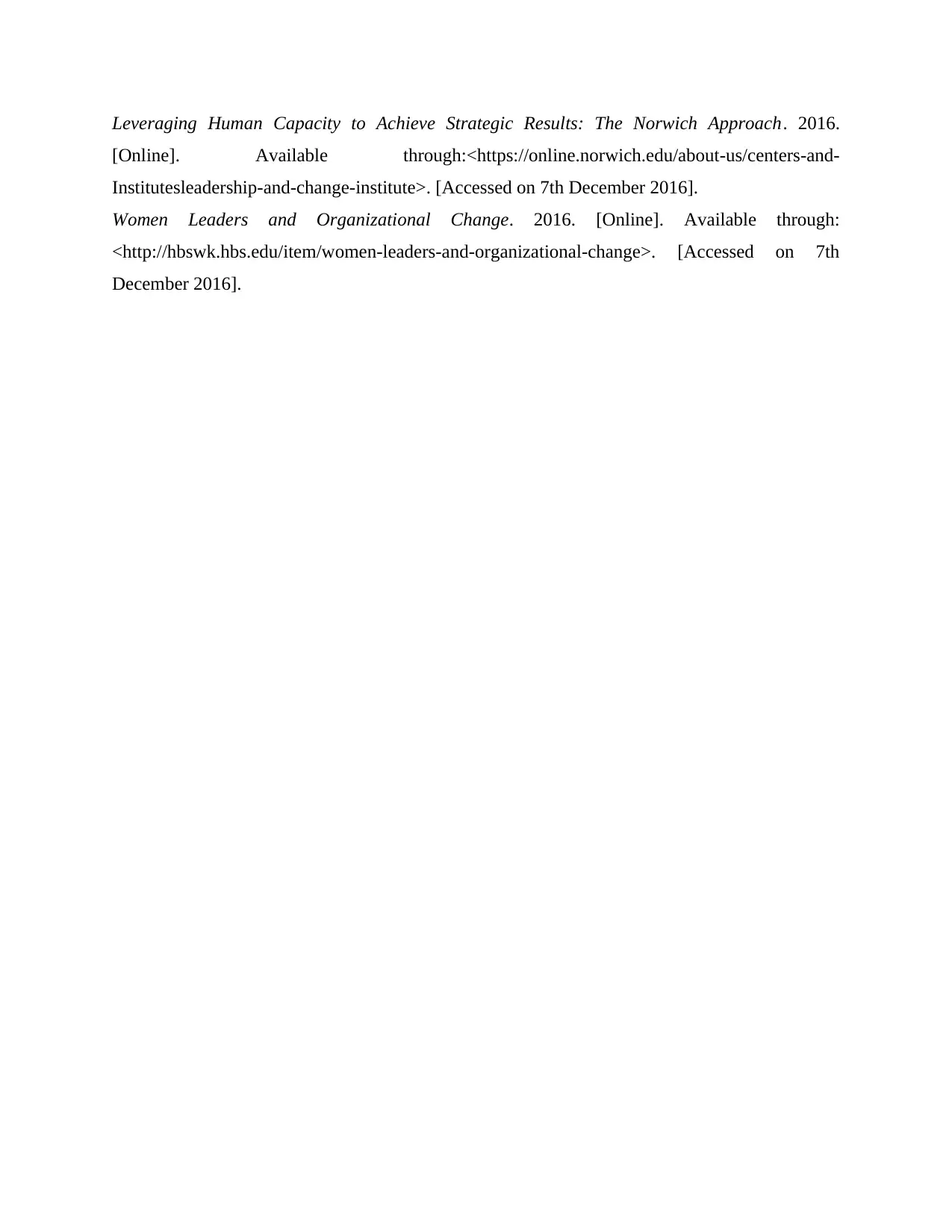
Leveraging Human Capacity to Achieve Strategic Results: The Norwich Approach. 2016.
[Online]. Available through:<https://online.norwich.edu/about-us/centers-and-
Institutesleadership-and-change-institute>. [Accessed on 7th December 2016].
Women Leaders and Organizational Change. 2016. [Online]. Available through:
<http://hbswk.hbs.edu/item/women-leaders-and-organizational-change>. [Accessed on 7th
December 2016].
[Online]. Available through:<https://online.norwich.edu/about-us/centers-and-
Institutesleadership-and-change-institute>. [Accessed on 7th December 2016].
Women Leaders and Organizational Change. 2016. [Online]. Available through:
<http://hbswk.hbs.edu/item/women-leaders-and-organizational-change>. [Accessed on 7th
December 2016].
⊘ This is a preview!⊘
Do you want full access?
Subscribe today to unlock all pages.

Trusted by 1+ million students worldwide
1 out of 9
Related Documents
Your All-in-One AI-Powered Toolkit for Academic Success.
+13062052269
info@desklib.com
Available 24*7 on WhatsApp / Email
![[object Object]](/_next/static/media/star-bottom.7253800d.svg)
Unlock your academic potential
Copyright © 2020–2025 A2Z Services. All Rights Reserved. Developed and managed by ZUCOL.





